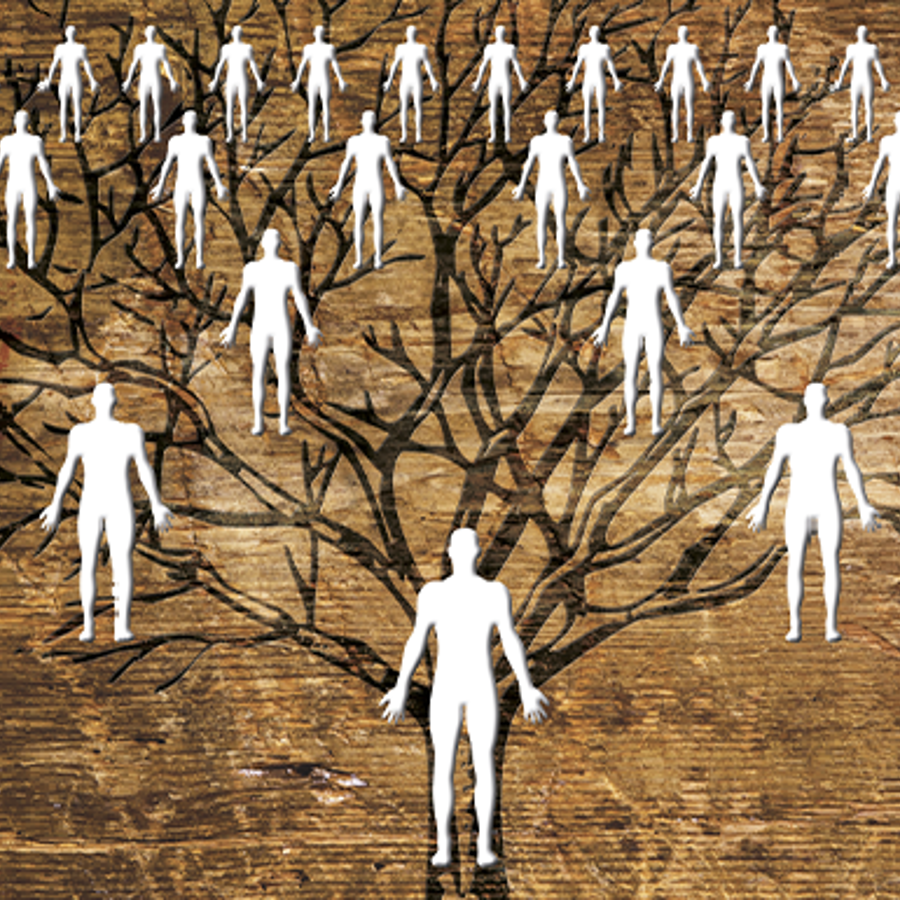
How far back can an ancestry test go?
April 18, 2012

- Related Topics:
- Consumer genetic testing,
- Paternity tests,
- Ancestry,
- Ancestry tests,
- Relatedness
A high school student from Virginia asks:
"About how far back can a standard genetic test trace family lineage and how accurate will the results be the further back they go? How good are they at telling how related two people are?"
Some tests can go back thousands of years. But they don’t tell you a lot. They can only tell you about a tiny part of your ancestry.
Those are the “paternal haplogroup” and “maternal haplogroup” type genetic tests. They are fun though because you can sometimes figure out if you’re distantly related to Genghis Khan. Or Abraham Lincoln or anyone else famous who has been tested.
Other tests can tell you a lot more about your relatives. For example, some newer tests like 23andMe offer can tell if two people are up to fifth cousins.
This is way better than the standard paternity sorts of tests can do though. Without testing many relatives, they have trouble telling if two people are brother and sister let alone fifth cousins.
The reason for the difference has to do with how much DNA each test looks at. Paternity tests look at a few, small bits of DNA. They are really too few to get a good picture without many family members being tested.
“Paternal haplogroup” type tests look only at the Y chromosome, which is passed from father to son. “Maternal haplogroup” type tests look only at the mitochondria, which are passed from mother to child. These are great for distant ancestry, but only give information about a tiny part of your family tree.
Other tests look at lots of DNA. So much so that they can see if two people share large pieces of DNA. This is why they can tell if two people are likely to be third, fourth or even fifth cousins.
What I’ll do for the rest of the answer is compare these tests so you can get a feel for what each can tell us. As you’ll see, the newer tests can tell you a lot more with many fewer relatives getting tested.

Paternity tests: Great for identifying a parent/child
DNA is passed down from parents to their children in small packages called chromosomes. People typically have 23 pairs of these DNA packages. One from each pair comes from mom and the other from dad. This is why half of our DNA comes from our mom and half comes from our dad.
A standard paternity test compares a few spots on mom’s, dad’s, and child’s DNA. They typically look at around 15 or 20 spots.

These tests have tended to focus on places in the DNA where a certain part of the DNA is repeated. For example, some people may have 10 copies of ATG at a certain site but others might have a different number, like 9 or 12.
The child, mother and possible father’s DNA are compared at the 15 or 20 different spots. Let’s take a look at what one of those spots might look like:
- Mother: 13, 14
- Possible Dad: 11, 12
- Child: 12, 13
The first number is the number of repeats on one chromosome and the second number is the number of repeats on the second one. So the child has 12 repeats on one chromosome and 13 on the other at a certain spot on those chromosomes.
One of each of those chromosomes came from each parent so one of the repeats should match to the parent it came from. In this case, mom gave the child a 13 and so his father had to give him a 12. If dad didn’t have a 12 to give, then he is less likely to be the dad.
Of course just because he has a 12, that doesn’t mean he is the dad! Lots of men have a 12. That is why they test so many different spots. All but one or two need to match for the man to be the dad.
Now imagine that we have two men who want to figure out if they are brothers. And let’s say they share these same parents and that the parents are not being tested.
Around 25% of the time, the brothers might not share any DNA at this spot. One brother might be 11,14 and one 12,13. As you can see, these tests are already tricky with even close relatives.
You can imagine that it would be hard to tell if someone is a first cousin let alone a fifth cousin this way. The test looks at too little DNA to see the relationship. The same is not true for the newer tests.
Ancestry tests: Great for finding relatives
The newer tests are able to look at more DNA. Which means we can see relationships that the other tests miss. This type of test is called an “autosomal DNA test”.
But you can’t go back in time forever with these tests. Eventually the shared bits of DNA become too small to reliably link to someone else. This happens because of something called recombination.
Remember, we get one chromosome from each parent. But we don’t get an exact one that our parent had. Instead we get one that is a mix of the two in that parent’s pair.

For example, the chromosome 1 you got from your mom is a mix of her two chromosome 1′s. On average it has about half from one of her 1′s and half from the other. The same is true for all of your other chromosomes (except for the Y in men and mitochondrial DNA in everyone).
This is the recombination I was talking about before. It serves you up a unique, never before seen chromosome.
While this is great for making us each unique, it makes tracing relatives tricky. It makes it so there are no longer large pieces of DNA that can be matched back to a distant relative after only about five generations.
Below I have tried to give you a feel for why this is by tracing some cousins on a family tree.

By following the shared bit of red DNA, you can see that the further apart relatives get, the less DNA they share in common. That’s why it is easier to test relatives that are more closely related.
But you can also see how it gets trickier and trickier to see the shared DNA. The only reason we can see people related after five generations is because we have 46 chromosomes to work with. At least one will share a bit of DNA.
One day when we can easily read all of our DNA, we may be able to go back even further. But in special situations, we may not have to wait. There are tests available right now that can find a few relatives from even thousands of years ago.
Mitochondria and Y chromosome tests: Tracing a few relatives very far
Remember when I said that the Y chromosome and mitochondrial DNA (mtDNA) don’t recombine? Well, this makes it possible for us to trace these chromosomes back into the distant past.
In fact, we can trace the mtDNA back to a woman from about 150,000 or 200,000 years ago that everyone on the planet is related to. And the Y chromosome to a man we’re all related to from 60,000 or so years ago. Scientists have dubbed them Mitochondrial Eve and Y Adam.
As you can tell, we can use these tests to find distant relatives. But they only reveal one thin slice of our past.
With mtDNA, you can only trace one maternal line back in time. That is because this DNA is passed from mother to child. And you can only trace a single paternal line with the Y since it is passed from father to son. As you can see below, you lose an awful lot of relatives this way!

You can only trace the pink folks with mtDNA and the blue folks with the Y chromosome. So your mom’s dad is invisible with a mtDNA test. And so are all of his relatives. Same thing with dad’s mom and all her relatives. With each generation you lose more and more relatives this way.
As you can see, there isn’t just one simple test for tracing your family lineage. Each different test will give you different information. But if you have an idea of what kind of information you want and a basic understanding of genetics there is a lot of information that you can learn about your family!

Author: Nadine Rayes
When this answer was published in 2012, Nadine was a student in the Stanford MS Program in Human Genetics and Genetic Counseling. Nadine wrote this answer while participating in the Stanford at The Tech program.
 Skip Navigation
Skip Navigation
